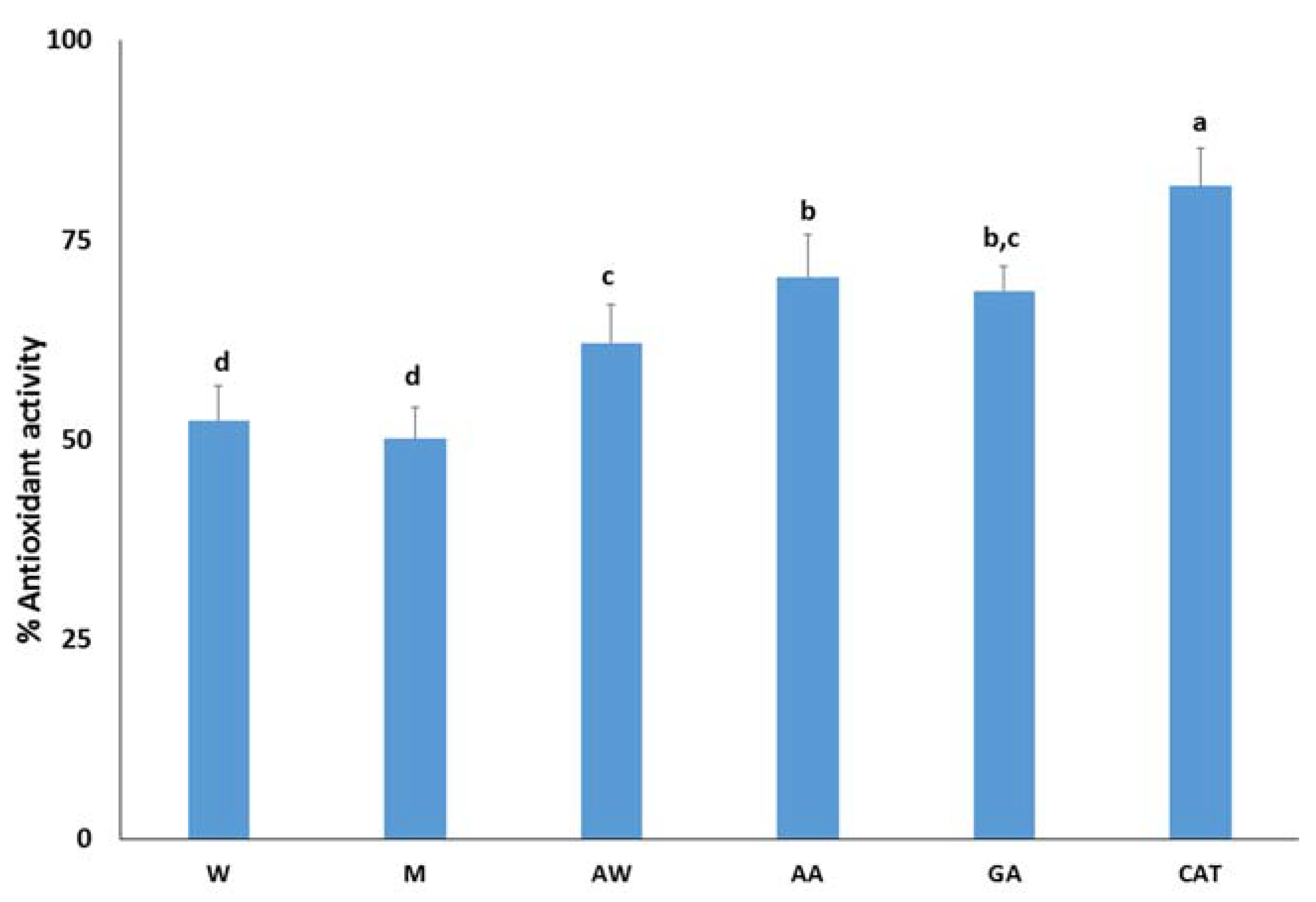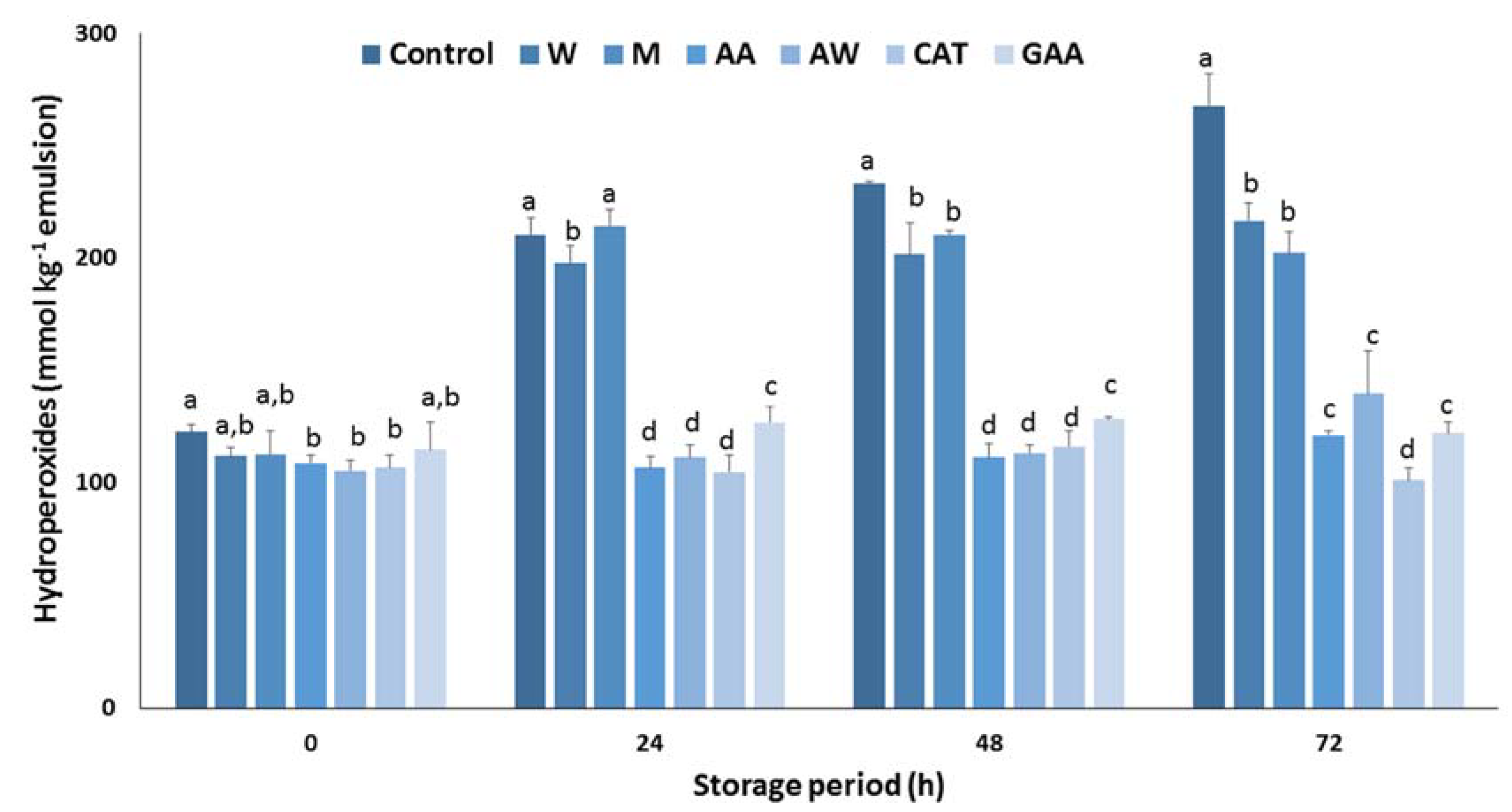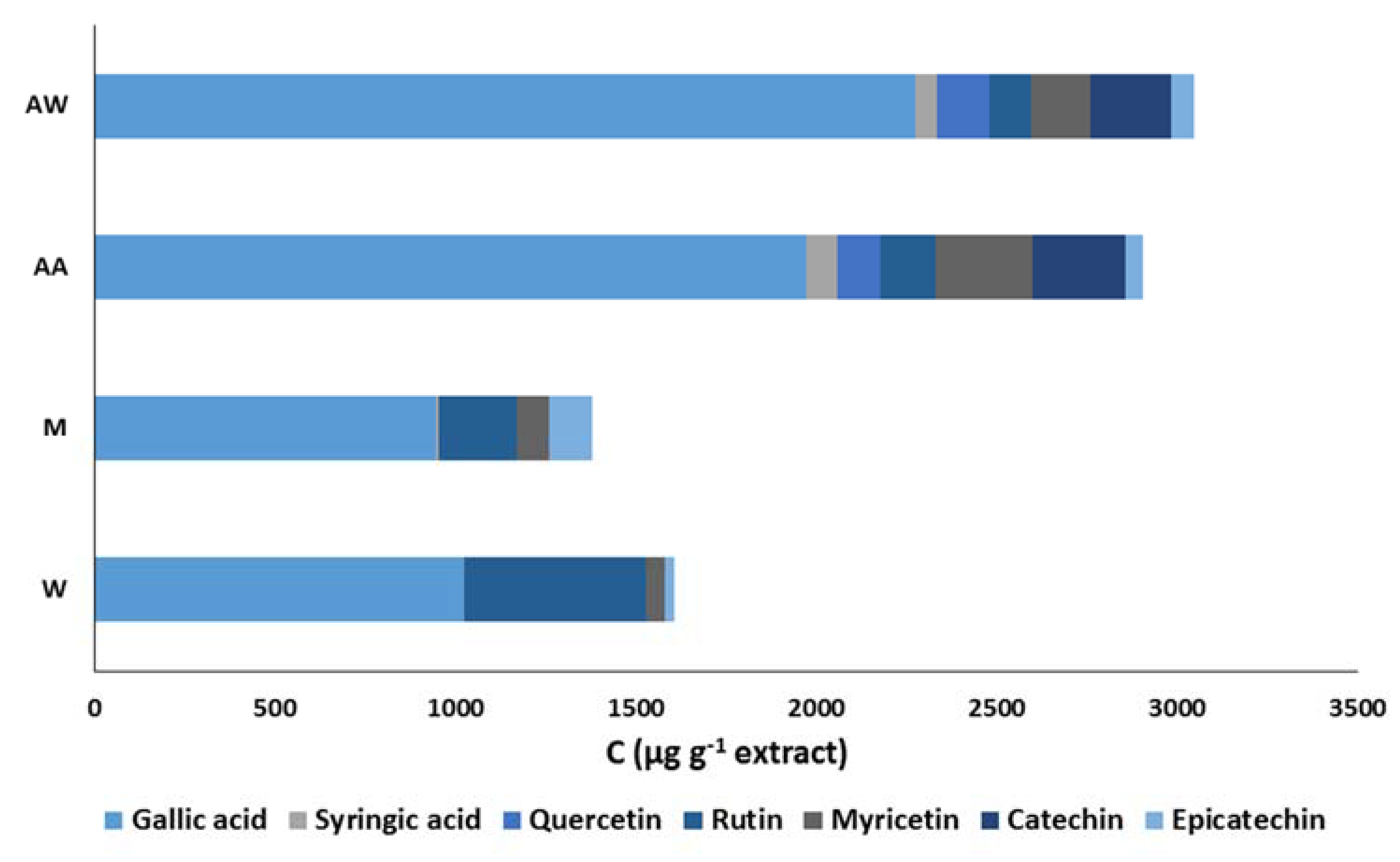Utilization of Carob Fruit as Sources of Phenolic Compounds with Antioxidant Potential: Extraction Optimization and Application in Food Models
Abstract
1. Introduction
2. Materials and Methods
2.1. Chemicals and Fruit Material
2.2. Preparation of Carob Fruit Extracts
2.3. Total Phenolic Content by High-Throughput Folin–Ciocalteu Assay
2.4. Total Flavonoids by High-Throughput Technique
2.5. Antioxidant Activity by DPPH and Ferric Reducing Antioxidant Power (FRAP) High-Throughput Techniques
2.6. Antioxidant Effect of Carob Fruit Extracts in β-Carotene-Linoleate Model System
2.7. Antioxidant Effect of Carob Fruit Extracts in Sunflower Oil
2.8. Antioxidant Effect of Carob Fruit Extracts in Oil-in-Water Emulsion
2.9. Antioxidant Effect of Carob Fruit Extracts in Pork Model System
2.10. Identification and Quantification of Phenolic Compounds Using HPLC
2.11. HPLC Coupled on a Pre-Column DPPH Assay
2.12. Statistical Analysis
3. Results and Discussion
3.1. Effects of Solvent Systems and Carob Variety on Phenolic Composition and Antioxidant Activity
3.2. Antioxidative Effect of Carob Extracts in Model Food Systems
3.3. Determination of Antioxidant Phenolic Constituents of Carob Extracts
4. Conclusions
Author Contributions
Funding
Acknowledgments
Conflicts of Interest
References
- Ngo, D.H.; Wijesekara, I.; Vo, T.S.; Van Ta, Q.; Kim, S.K. Marine Food-Derived Functional Ingredients as Potential Antioxidants in the Food Industry: An Overview. Food Res. Int. 2011, 44, 523–529. [Google Scholar] [CrossRef]
- Taghvaei, M.; Jafari, S.M. Application and Stability of Natural Antioxidants in Edible Oils in Order to Substitute Synthetic Additives. J. Food Sci. Technol. 2015, 52, 1272–1282. [Google Scholar] [CrossRef] [PubMed]
- Botsaris, G.; Orphanides, A.; Yiannakou, E.; Gekas, V.; Goulas, V. Antioxidant and Antimicrobial Effects of Pistacia Lentiscus L. Extracts in Pork Sausages. Food Technol. Biotechnol. 2015, 53. [Google Scholar] [CrossRef] [PubMed]
- Goulas, V.; Stylos, E.; Chatziathanasiadou, M.V.; Mavromoustakos, T.; Tzakos, A.G. Functional Components of Carob Fruit: Linking the Chemical and Biological Space. Int. J. Mol. Sci. 2016, 17, 1875. [Google Scholar] [CrossRef]
- Nasar-Abbas, S.M.; e-Huma, Z.; Vu, T.H.; Khan, M.K.; Esbenshade, H.; Jayasena, V. Carob Kibble: A Bioactive-Rich Food Ingredient. Compr. Rev. Food Sci. Food Saf. 2016, 15, 63–72. [Google Scholar] [CrossRef]
- Loullis, A.; Pinakoulaki, E. Carob as Cocoa Substitute: A Review on Composition, Health Benefits and Food Applications. Eur. Food Res. Technol. 2017, 244, 1–19. [Google Scholar] [CrossRef]
- Owen, R.W.; Haubner, R.; Hull, W.E.; Erben, G.; Spiegelhalder, B.; Bartsch, H.; Haber, B. Isolation and Structure Elucidation of the Major Individual Polyphenols in Carob Fibre. Food Chem. Toxicol. 2003, 41, 1727–1738. [Google Scholar] [CrossRef]
- Goulas, V.; Hadjisolomou, A. Dynamic Changes in Targeted Phenolic Compounds and Antioxidant Potency of Carob Fruit (Ceratonia Siliqua L.) Products during in Vitro Digestion. Lwt Food Sci. Technol. 2019, 101, 269–275. [Google Scholar] [CrossRef]
- Cavdarova, M.; Makris, D.P. Extraction Kinetics of Phenolics from Carob (Ceratonia siliqua L.) Kibbles Using Environmentally Benign Solvents. Waste Biomass Valoriz. 2014, 5, 773–779. [Google Scholar] [CrossRef]
- Bernardo-Gil, M.G.; Roque, R.; Roseiro, L.B.; Duarte, L.C.; Gírio, F.; Esteves, P. Supercritical Extraction of Carob Kibbles (Ceratonia siliqua L.). J. Supercrit. Fluids 2011, 59, 36–42. [Google Scholar] [CrossRef]
- Roseiro, L.B.; Tavares, C.S.; Roseiro, J.C.; Rauter, A.P. Antioxidants from Aqueous Decoction of Carob Pods Biomass (Ceretonia siliqua L.): Optimisation Using Response Surface Methodology and Phenolic Profile by Capillary Electrophoresis. Ind. Crops Prod. 2013, 44, 119–126. [Google Scholar] [CrossRef]
- Bastida, S.; Sánchez-Muniz, F.J.; Olivero, R.; Pérez-Olleros, L.; Ruiz-Roso, B.; Jiménez-Colmenero, F. Antioxidant Activity of Carob Fruit Extracts in Cooked Pork Meat Systems during Chilled and Frozen Storage. Food Chem. 2009, 116, 748–754. [Google Scholar] [CrossRef]
- Albertos, I.; Jaime, I.; María Diez, A.; González-Arnaiz, L.; Rico, D. Carob Seed Peel as Natural Antioxidant in Minced and Refrigerated (4°C) Atlantic Horse Mackerel (Trachurus trachurus). LWT - Food Sci. Technol. 2015, 64, 650–656. [Google Scholar] [CrossRef]
- Zulim Botega, D.; Bastida, S.; Marmesat, S.; Pérez-Olleros, L.; Ruiz-Roso, B.; Sánchez-Muniz, F.J. Carob Fruit Polyphenols Reduce Tocopherol Loss, Triacylglycerol Polymerization and Oxidation in Heated Sunflower Oil. JAOCS J. Am. Oil Chem. Soc. 2009, 86, 419–425. [Google Scholar] [CrossRef]
- Sȩczyk, Ł.; Swieca, M.; Gawlik-Dziki, U. Effect of Carob (Ceratonia Siliqua L.) Flour on the Antioxidant Potential, Nutritional Quality, and Sensory Characteristics of Fortified Durum Wheat Pasta. Food Chem. 2016, 194, 637–642. [Google Scholar] [CrossRef]
- Srour, N.; Daroub, H.; Toufeili, I.; Olabi, A. Developing a Carob-Based Milk Beverage Using Different Varieties of Carob Pods and Two Roasting Treatments and Assessing Their Effect on Quality Characteristics. J. Sci. Food Agric. 2016, 96, 3047–3057. [Google Scholar] [CrossRef]
- Magalhães, L.M.; Santos, F.; Segundo, M.A.; Reis, S.; Lima, J.L.F.C. Rapid Microplate High-Throughput Methodology for Assessment of Folin-Ciocalteu Reducing Capacity. Talanta 2010, 83, 441–447. [Google Scholar] [CrossRef]
- Herald, T.J.; Gadgil, P.; Tilley, M. High-Throughput Micro Plate Assays for Screening Flavonoid Content and DPPH-Scavenging Activity in Sorghum Bran and Flour. J. Sci. Food Agric. 2012, 92, 2326–2331. [Google Scholar] [CrossRef]
- Nuengchamnong, N.; Krittasilp, K.; Ingkaninan, K. Rapid Screening and Identification of Antioxidants in Aqueous Extracts of Houttuynia cordata Using LC-ESI-MS Coupled with DPPH Assay. Food Chem. 2009, 117, 750–756. [Google Scholar] [CrossRef]
- Huber, G.M.; Rupasinghe, H.P.V. Phenolic Profiles and Antioxidant Properties of Apple Skin Extracts. J. Food Sci. 2009, 74, 693–700. [Google Scholar] [CrossRef]
- Chandrasekara, N.; Shahidi, F. Antioxidative Potential of Cashew Phenolics in Food and Biological Model Systems as Affected by Roasting. Food Chem. 2011, 129, 1388–1396. [Google Scholar] [CrossRef]
- Ospina, M.; Montaña-Oviedo, K.; Díaz-Duque, Á.; Toloza-Daza, H.; Narváez-Cuenca, C.E. Utilization of Fruit Pomace, Overripe Fruit, and Bush Pruning Residues from Andes Berry (Rubus glaucus benth) as Antioxidants in an Oil in Water Emulsion. Food Chem. 2019, 281, 114–123. [Google Scholar] [CrossRef] [PubMed]
- Zhang, C.; Shen, X.; Chen, J.; Jiang, X.; Hu, F.L. Identification of Free Radical Scavengers from Brazilian Green Propolis Using Off-Line HPLC-DPPH Assay and LC-MS. J. Food Sci. 2017, 82, 1602–1607. [Google Scholar] [CrossRef] [PubMed]
- Zhong, L.; Yuan, Z.; Rong, L.; Zhang, Y.; Xiong, G.; Liu, Y.; Li, C. An Optimized Method for Extraction and Characterization of Phenolic Compounds in Dendranthema indicum var. aromaticum Flower. Sci. Rep. 2019, 9, 7745. [Google Scholar] [CrossRef] [PubMed]
- Domínguez-Rodríguez, G.; Marina, M.L.; Plaza, M. Strategies for the Extraction and Analysis of Non-Extractable Polyphenols from Plants. J. Chromatogr. A 2017, 1514, 1–15. [Google Scholar] [CrossRef] [PubMed]
- Orphanides, A.; Goulas, V.; Gekas, V. Introducing the Concept of Sono-Chemical Potential: A Phenomenological Model for Ultrasound Assisted Extraction. J. Food Eng. 2014, 120, 191–196. [Google Scholar] [CrossRef]
- Stalikas, C.D. Extraction, Separation, and Detection Methods for Phenolic Acids and Flavonoids. J. Sep. Sci. 2007, 30, 3268–3295. [Google Scholar] [CrossRef]
- Garcia-Salas, P.; Morales-Soto, A.; Segura-Carretero, A.; Fernández-Gutiérrez, A. Phenolic-Compound-Extraction Systems for Fruit and Vegetable Samples. Molecules 2010, 15, 8813–8826. [Google Scholar] [CrossRef]
- Galanakis, C.M.; Goulas, V.; Tsakona, S.; Manganaris, G.A.; Gekas, V. A Knowledge Base for the Recovery of Natural Phenols with Different Solvents. Int. J. Food Prop. 2013, 16, 382–396. [Google Scholar] [CrossRef]
- Bhebhe, M.; Füller, T.N.; Chipurura, B.; Muchuweti, M. Effect of Solvent Type on Total Phenolic Content and Free Radical Scavenging Activity of Black Tea and Herbal Infusions. Food Anal. Methods 2016, 9, 1060–1067. [Google Scholar] [CrossRef]
- Papagiannopoulos, M.; Wollseifen, H.R.; Mellenthin, A.; Haber, B.; Galensa, R. Identification and Quantification of Polyphenols in Carob Fruits (Ceratonia siliqua L.) and Derived Products by HPLC-UV-ESI/MSn. J. Agric. Food Chem. 2004, 52, 3784–3791. [Google Scholar] [CrossRef] [PubMed]
- Rakib, E.M.; Chicha, H.; Abouricha, S.; Alaoui, M. Determination of Phenolic Composition of Carob Pods Grown in Different Regions of Morocco. J. Nat. Prod. 2010, 3, 134–140. [Google Scholar]
- Schwarz, K.; Bertelsen, G.; Nissen, L.R.; Gardner, P.T.; Heinonen, M.I.; Hopia, A.; Huynh-Ba, T.; Lambelet, P.; McPhail, D.; Skibsted, L.H.; et al. Investigation of Plant Extracts for the Protection of Processed Foods against Lipid Oxidation. Comparison of Antioxidant Assays Based on Radical Scavenging, Lipid Oxidation and Analysis of the Principal Antioxidant Compounds. Eur. Food Res. Technol. 2001, 212, 319–328. [Google Scholar] [CrossRef]
- Nenadis, N.; Tsimidou, M. Observations on the Estimation of Scavenging Activity of Phenolic Compounds Using Rapid 1,1-Diphenyl-2-Picrylhydrazyl (DPPH.) Tests. JAOCS J. Am. Oil Chem. Soc. 2002, 79, 1191–1195. [Google Scholar] [CrossRef]
- Jia, Z.S.; Zhou, B.; Yang, L.; Wu, L.M.; Liu, Z.L. Antioxidant Synergism of Tea Polyphenols and α-Tocopherol against Free Radical Induced Peroxidation of Linoleic Acid in Solution. J. Chem. Soc. Perkin Trans. 2 1998, 1, 911–915. [Google Scholar] [CrossRef]
- Burda, S.; Oleszek, W. Antioxidant and Antiradical Activities of Flavonoids. J. Agric. Food Chem. 2001, 49, 2774–2779. [Google Scholar] [CrossRef] [PubMed]
- Dangles, O.; Dufour, C.; Fargeix, G. Inhibition of lipid peroxidation by quercetin and quercetin derivatives: Antioxidant and Prooxidant Effects. J. Chem. Soc. Perkin Trans. 2000, 2, 1215–1222. [Google Scholar] [CrossRef]
- Marinova, E.; Toneva, A.; Yanishlieva, N. Synergistic Antioxidant Effect of α-Tocopherol and Myricetin on the Autoxidation of Triacylglycerols of Sunflower Oil. Food Chem. 2008, 106, 628–633. [Google Scholar] [CrossRef]




| Solvent System | TPC (mg GAE1 100 g−1) | TFC (mg CE2 100 g−1) | DPPH IC503 (mg mL−1) | FRAP (mg FeSO4 100 g−1) |
|---|---|---|---|---|
| ‘Tilliria’ Carob Fruit | ||||
| 100% Water | 382.0 ± 23.8 a | 22.9 ± 0.3 i,j | 1.9 ± 0.2 f,g,h,i | 339.7 ± 4.0 a |
| 100% Methanol | 359.6 ± 13.5 a,b,c | 26.8 ± 3.7 h,i | 2.8 ± 0.1 e,f | 338.7 ± 39.3 a |
| 100% Ethanol | 145.7 ± 19.0 k | 8.7 ± 0.1 l,m | 6.4 ± 0.9 b | 296.4 ± 19.8 a,b,c |
| 100% Acetone | 80.3 ± 6.9 l | Not detected | > 20 a | 98.8 ± 5.5 j |
| 100% Ethyl acetate | 7.1 ± 0.9 m | 5.7 ± 1.0 m,n | > 20 a | 29.2 ± 4.1 k |
| Methanol + water + HCl (80:19:1, v/v/v) | 288.4 ± 19.4 h | 70.5 ± 1.8 c | 1.6±0.2g,h,i | 245.5 ± 28.1 c,d,e,f |
| Ethanol + water + HCl (80:19:1, v/v/v) | 315.8 ± 6.7 e,f,g,h | 55.7 ± 5.7 d,e,f | 2.1±0.4 e,f,g,h,i | 270.2 ± 7.4 b,c,d |
| Acetone + water + HCl (80:19:1, v/v/v) | 348.6 ± 5.8 a,b,c,d,e | 98.7 ± 2.4 a | 1.4 ± 0.0 h,i | 271.6 ± 29.1 b,c,d |
| Methanol + water (80:20, v/v) | 342.2 ± 9.4 b,c,d,e | 49.3 ± 1.4 f | 2.2 ± 0.5 e,f,g,h,i | 205.7 ± 8.9 f,e,g,h |
| Methanol + water (50:50, v/v) | 362.0 ± 5.9 a,b | 51.2 ± 0.1 f | 1.9 ± 0.2 e,f,g,h,i | 257.8 ± 31.8 c,d,e |
| Ethanol + water (80:20, v/v) | 304.2 ± 3.4 f,g,h | 22.7 ± 2.7 i,j | 2.9 ± 0.2 e,f, | 335.6 ± 0.6 a |
| Ethanol + water (50:50, v/v) | 323.9 ± 3.0 c,d,e,f,g,h | 52.8 ± 0.9 e,f | 2.1 ± 0.3 e,f,g,h,i | 195.5 ± 3.3 e.g,h |
| Acetone + water (80:20, v/v) | 328.6 ± 2.0 b,c,d,e,f,g | 88.6 ± 9.0 b | 1.6 ± 0.2 i | 224.2 ± 9.1 d,e,f,g,h |
| Acetone + water (50:50, v/v) | 347.2 ± 1.8 a,b,c,d,e | 77.2 ± 6.7 c | 1.4 ± 0.1 h,i | 227.1 ± 27.8 d,e,f,g |
| ‘Koumbota’ Carob Fruit | ||||
| 100% Water | 351.6 ± 16.2 a,b,c,d,e | 27.1 ± 1.7 h,i | 2.0 ± 0.4 e,f,g,h,i | 324.1 ± 37.1 a,b |
| 100% Methanol | 323.0 ± 10.3 c,d,e,f,g,h | 10.3 ± 1.7 l,m | 2.4 ± 0.2 e,g | 259.1 ± 36.9 c,d,e |
| 100% Ethanol | 204.9 ± 8.6 j | 3.7 ± 0.7 m,n | 4.3 ± 0.2 c | 209.9 ± 37.7 f,e,g,h |
| 100% Acetone | 57.9 ± 3.5 l | 15.5 ± 2.0 j,k,l | > 20 a | 79.4 ± 1.4 j,k |
| 100% Ethyl acetate | 17.4 ± 4.3 m | 16.3 ± 1.7 j,k,l | > 20 a | 41.1 ± 6.5 k |
| Methanol + water+ HCl (80:19:1, v/v/v) | 343.2 ± 33.7 b,c,d,e | 38.8 ± 3.0 g | 1.8 ± 0.2 f,g,h,i | 225.5 ± 38.3 d,e,f,g,h |
| Ethanol + water+ HCl (80:19:1, v/v/v) | 320.8 ± 28.6 d,e,f,g,h | 33.4 ± 4.8 g,h | 2.3 ± 0.4 e,f,g,h,i | 320.8 ± 35.3 a,b |
| Acetone + water+ HCl (80:19:1, v/v/v) | 337.9 ± 5.5 b,c,d,e,f | 86.1 ± 5.3 b | 1.5 ± 0.1 g,h,i | 223 ± 22.8 d,e,f,g,h |
| Methanol + water (80:20, v/v) | 228.4 ± 25.8 i,j | 20.8 ± 1.6 i,j,k | 3.0 ± 0.4 d,e | 170.3 ± 10.4 g,h |
| Methanol + water (50:50, v/v) | 293.2 ± 32.0 g,h | 18.4 ± 2.2 j,k | 2.6 ± 0.1 e,f,g,h | 187.9 ± 16.8 e,f,g,h |
| Ethanol + water (80:20, v/v) | 255.0 ± 20.0 i | 13.9 ± 1.5 k,l | 4.0 ± 0.6 c,d | 281.8 ± 28 a,b,c,d |
| Ethanol + water (50:50, v/v) | 355.5 ± 22.9 a,b,c,d | 32.1 ± 3.2 g,h | 2.6 ± 0.3 e,f,g,h | 167.0 ± 3.1 h |
| Acetone + water (80:20, v/v) | 321.7 ± 11.2 c,d,e,f,g,h | 59.4 ± 3.2 d,e | 1.5 ± 0.0 g,h,i | 188.2 ± 24.6 e,f,g,h |
| Acetone + water (50:50, v/v) | 351.4 ± 4.1 a,b,c,d,e | 62.56 ± 6.1 d | 2.6 ± 0.1 e,f,g | 325.5 ± 27.7 a,b |
| Hydroxybenzoic Acids | Flavonols | Flavan-3-ols | |||||
|---|---|---|---|---|---|---|---|
| Extract | Gallic Acid | Syringic Acid | Quercetin | Rutin | Myricetin | Catechin | Epicatechin |
| Water | 80.08 | nd * | nd | 67.09 | 94.53 | nd | 77.33 |
| Methanol | 78.29 | 67.16 | nd | 72.37 | 92.68 | nd | 70.58 |
| Acidic Acetone | 74.66 | 56.64 | 89.66 | 82.36 | 85.99 | 79.54 | 79.08 |
| Acetone Water | 71.89 | 51.25 | 88.91 | 80.55 | 87.33 | 77.63 | 76.44 |
© 2019 by the authors. Licensee MDPI, Basel, Switzerland. This article is an open access article distributed under the terms and conditions of the Creative Commons Attribution (CC BY) license (http://creativecommons.org/licenses/by/4.0/).
Share and Cite
Goulas, V.; Georgiou, E. Utilization of Carob Fruit as Sources of Phenolic Compounds with Antioxidant Potential: Extraction Optimization and Application in Food Models. Foods 2020, 9, 20. https://doi.org/10.3390/foods9010020
Goulas V, Georgiou E. Utilization of Carob Fruit as Sources of Phenolic Compounds with Antioxidant Potential: Extraction Optimization and Application in Food Models. Foods. 2020; 9(1):20. https://doi.org/10.3390/foods9010020
Chicago/Turabian StyleGoulas, Vlasios, and Eva Georgiou. 2020. "Utilization of Carob Fruit as Sources of Phenolic Compounds with Antioxidant Potential: Extraction Optimization and Application in Food Models" Foods 9, no. 1: 20. https://doi.org/10.3390/foods9010020
APA StyleGoulas, V., & Georgiou, E. (2020). Utilization of Carob Fruit as Sources of Phenolic Compounds with Antioxidant Potential: Extraction Optimization and Application in Food Models. Foods, 9(1), 20. https://doi.org/10.3390/foods9010020






